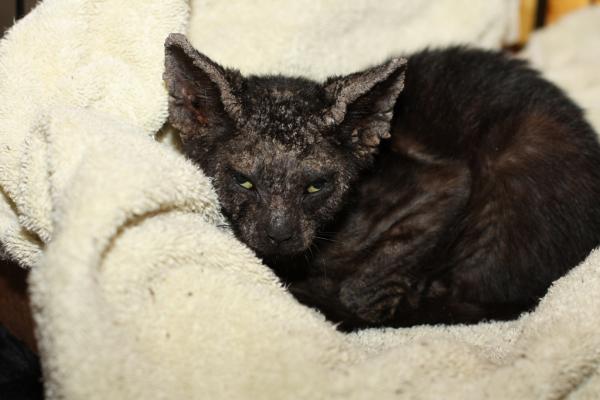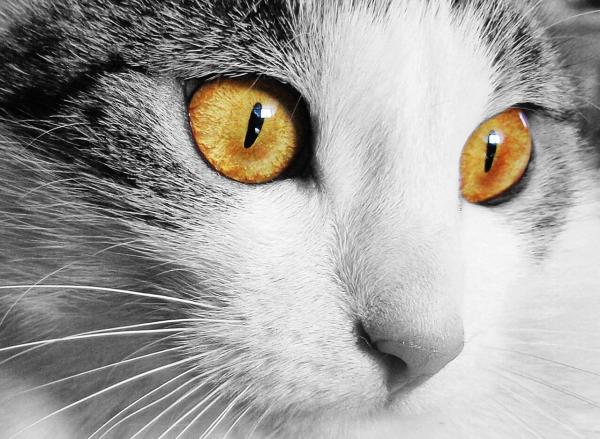Scabies in cats – Symptoms and treatment

Scabies is a cutaneous disease, caused by a microscopic ectoparasite that can occur in numerous animal species, including humans, and is found throughout the world. It is contagious by contact, produces a series of symptoms that make it easily recognizable and usually has an easy solution.
As soon as we detect any symptoms in our pets, we must quickly go to our trusted veterinarian to proceed with the corresponding tests and act as soon as possible. In this article, we are going to focus on scabies in cats, what are their symptoms and their treatment.
What types of scabies affect cats and what parasites produce them?
The ectoparasite that causes scabies is a mite, of which there are several species and subspecies that can affect in different ways. We found mites that dig tunnels in the skin of the affected animal as they feed on it and mites that instead of digging into the skin, stay on the surface and feed on the keratin.
Focusing on domestic cats, we found that the most common types of scabies are, from most to least, feline conditions:
- La nooedric mange, produced by Notoedres Cati. It only occurs in cats.
- La otodectic mange or of the ears, produced by the mite Otodectes Cynotis. It occurs mostly in cats and occasionally in dogs.
- La queiletielosis or “walking dandruff”, can be confused with dandruff, but if you look carefully you can see how the mites move. Produced by Cheyletiella Spp. It occurs mainly in cats and sometimes in dogs.
- La demodectic mange, produced by Demodex Cati. It is especially found in dogs (Demodex Canis), but occasionally in cats.

Is there any race more prone to this disease?
The answer is that there is no more propensity to contract scabies because it is of one race or another, or none at all. So any domestic cat of any race and even of any age, can have scabies whenever it is not foreseen or treated.

Contagious feline scabies
Scabies is always spread by Contact with another infected animal with the mites responsible for it, or with objects that the animal can touch or use. Therefore we must always pay close attention to the contact that our cat may have with other animals susceptible to being infected, either because he lives inside and outside the home (lives in contact with the outside) or because we have an animal already sick in the Same house.
In case of detecting that one of our animals has scabies, we should separate the sick animal from the rest and start with their treatment (prescribed by the veterinarian), preventing any garment or object from passing to other animals and disinfect beds, feeders, blankets and toys that may have been infested with mites.
Rarely, this type of scabies is transmitted to humans, except for the queiletielosis that can be passed on to humans even though it affects us in a more transient way.
Symptoms of scabies in cats
As there are different types of scabies produced by different types of mites, the symptoms can be very diverse, but in the case of cats the most common and easily recognizable symptoms are:
- Restlessness. Our pet can not rest or lie down due to the discomfort caused by mites.
- Itching excessive, especially on the head and ears which is where scabies attacks the most. This itching produces a abundantscratched and licked of the affected areas.
- Hair loss in the affected areas.
- Redness of the skin inflammation of the area, accompanied by eczema and peeling of the affected skin.
- Wounds and scabs. After scratching and licking in an uncontrolled way, wounds and scabs are produced that can become easily infected, so it is very important to follow the treatment given by the veterinarian.
- In the case of scabies in the ear area, as it affects the inside of the ear, we will find excess waxdark that can result in otitis. In extreme cases of out of control, bleeding or bleeding in the ears and even perforation in the eardrum may occur.

Prevention and treatment of scabies in cats
As prevention and treatments against different types of ectoparasites or external parasites there are different products that we can buy in specialized stores or in veterinarians. Some of these products are:
- Pipette or spot-on. Of external application. You can find all products and brands in Miscota. Generally its application is monthly, but we must follow the instructions of the prospectus of each specific product.
- Tablets, tablets, capsules and pastes. Internal treatment that can be a combination against ectoparasites and endoparasites.
- Injectables.
- Shampoos, aerosols, sprays, powders, eardrops, etc. Some products are: Sentry HC Earmite ree, Mita-Clear, ZooPharma Extra Mild Allergy, etc. It is important to note that the treatment collars that do serve against parasites such as ticks and fleas, do not usually serve against mites. For this reason, it is important to ensure that the product we acquire does act against mites in case of trying to prevent or treat scabies.
Both the prevention process and the treatment of scabies, must be taken by a veterinarian, because tests must be done to determine the type of scabies and the degree to which it is to decide what will be the most effective treatment to eliminate it. the time it is the least aggressive for our feline.

This article is merely informative, in .com we do not have the faculty to prescribe veterinary treatments or make any kind of diagnosis. We invite you to take your pet to the veterinarian in case of any type of condition or discomfort.
If you want to read more articles similar to Scabies in cats – Symptoms and treatment, we recommend that you enter in our section of parasitic diseases.


